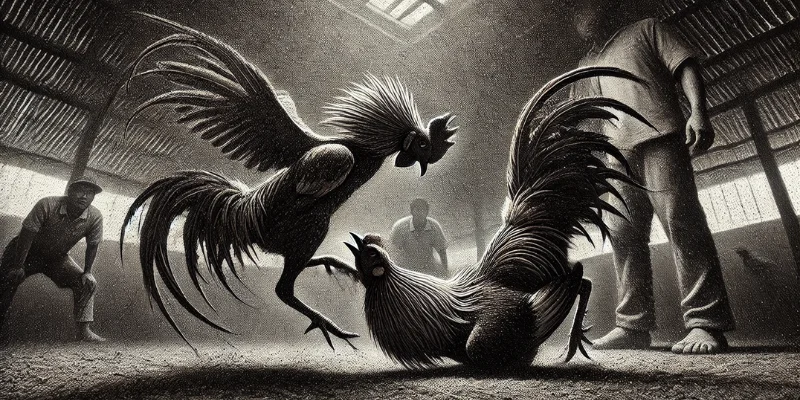
By: Carlos Mendoza, Rooster Breeding Specialist
Training a sabong rooster to become a champion is both an art and a science. As a seasoned breeder with years of experience in preparing roosters for cockfighting, I, Carlos Mendoza, understand the critical role equipment plays in creating a winning fighter. The right tools, combined with knowledge and careful preparation, will ensure your rooster is battle-ready. In this guide, I will walk you through the essential equipment needed for sabong rooster training, along with expert tips to maximize each tool’s effectiveness.
Choosing the Right Rooster Pen
The first step in training any rooster is providing a proper environment. The right rooster pen is critical for your bird’s health, conditioning, and overall development.
- Space and ventilation: Ensure the pen is large enough for movement, as cramped spaces can lead to muscle stiffness.
- Hygiene: Clean the pen regularly to avoid parasites and infections. A healthy environment equals a healthy bird.
- Shade and weatherproofing: The pen should protect the rooster from extreme weather, keeping them calm and comfortable. Extreme heat or cold can affect their performance.
Tip from Carlos Mendoza: A good pen gives your rooster room to spread its wings and practice light movement before the intensive training begins.
High-Quality Feeder and Waterer
Roosters need proper nutrition to build strength. A well-designed feeder and waterer can make feeding time more efficient.
- Material matters: Opt for stainless steel or durable plastic that won’t rust or crack.
- Easy access: Feeder openings should be wide enough for the rooster to feed without spilling or wasting too much grain.
- Water flow: An automatic waterer helps keep the water fresh and available 24/7.
This equipment ensures your rooster is hydrated and nourished, ready for the physical demands of sabong.
Carlos’ Tip: A well-fed rooster not only grows stronger but develops better endurance during training.
Rooster Leg Weights for Strength Training
Once your rooster is healthy and comfortable in its environment, it’s time to begin physical conditioning. Leg weights are a great tool for building leg strength and stamina.
- Gradual increase: Start with light weights and slowly increase over time to prevent muscle strain.
- Proper attachment: The weights must be securely fastened but not so tight that they cut off circulation.
- Consistent training: Use leg weights during daily walks or supervised free-roaming sessions.
Carlos’ Expert Insight: The key here is consistency. Don’t overload your rooster at the start. Gradual improvement is essential to avoid injuries.
Sabong Rooster Harness for Controlled Exercise
A training harness allows you to control your rooster’s movements while giving it enough freedom to build muscle and agility. Here’s what to look for in a good harness:
- Comfortable fit: The harness should fit snugly without restricting movement. Roosters need to move freely to develop muscle.
- Durability: Opt for strong materials like leather or reinforced fabric that can handle rough play and frequent use.
- Adjustable design: Ensure the harness can be adjusted as your rooster grows stronger and larger.
With a harness, you can work on different drills, such as controlled sprints, to enhance the rooster’s speed and reflexes.
Spurs and Attachments for Realistic Sparring Sessions
A rooster’s spurs are its natural weapons, but during training, using sparring spurs or blunt spurs is safer for both the rooster and its opponent.
- Blunt training spurs: These mimic the weight and feel of real spurs without causing injuries.
- Easy attachment: Make sure the spurs are easy to attach and remove, yet secure enough to stay in place during practice bouts.
- Realistic weight: Choosing the right weight for sparring spurs is important to simulate actual match conditions without overburdening the rooster.
Mendoza’s Note: Practice sparring with blunt spurs helps develop your rooster’s attack instincts while reducing the risk of injury before the actual fight.
Rooster Muffs for Safe Sparring
Muffs are small cushions used during sparring to protect the rooster’s head and body. This is particularly useful in training sessions to avoid unnecessary injuries.
- Thick padding: Choose muffs with thick, shock-absorbing materials to soften blows.
- Adjustable fit: Ensure the muffs fit properly around your rooster’s body and head, providing full protection during sparring.
- Durability: Opt for muffs made from sturdy materials that won’t tear or wear out quickly.
Training with muffs allows for more aggressive sparring, giving your rooster a chance to refine its fighting skills without causing permanent damage.
Rooster Conditioning Rake
A conditioning rake is an important tool used to simulate the sensation of combat. This tool can be used to gently stimulate your rooster’s skin, preparing it for the physical contact of sabong.
- Light pressure: Use the rake with light pressure to avoid injuring the rooster.
- Consistency: Incorporate this tool regularly into your routine so the rooster becomes accustomed to the sensation.
- Post-training use: This tool is ideal for use after sparring sessions to condition the skin.
Carlos’ Pro Tip: The conditioning rake not only prepares the skin but also helps the rooster mentally adjust to physical contact, which is key in competitive sabong.
Slasher Bag for Sparring Practice
A slasher bag is an excellent training tool that mimics the erratic movement of an opponent during sparring.
- Hanging placement: Suspend the slasher bag at the right height to simulate a rooster’s fighting posture.
- Reactive motion: When the rooster strikes the bag, it should move unpredictably, forcing the bird to react and adjust.
- Material and weight: The bag should be made of tough, durable material and filled with enough weight to simulate resistance.
Using this bag enhances your rooster’s agility, reflexes, and ability to react to unexpected strikes in a match.
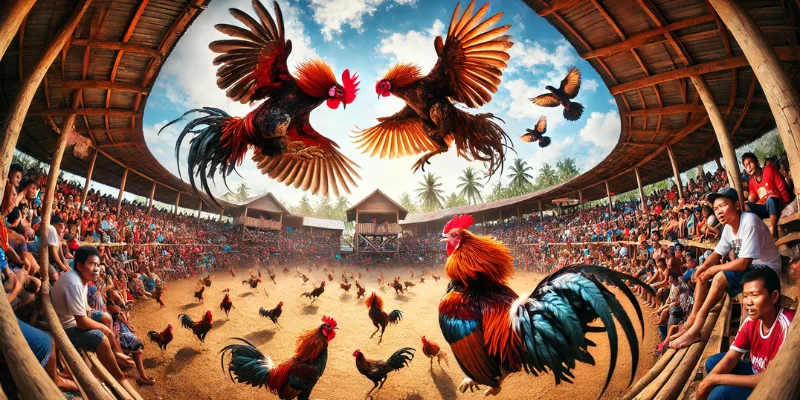 Rooster Treadmill for Cardiovascular Training
Rooster Treadmill for Cardiovascular Training
Stamina is critical for a champion rooster. The rooster treadmill is a specialized piece of equipment designed to improve cardiovascular health and build endurance.
- Adjustable speed: A good treadmill allows you to control the speed, gradually increasing it as the rooster builds stamina.
- Time control: Limit treadmill use to short bursts, and increase time as the rooster progresses.
- Safety measures: Ensure that the treadmill has protective barriers to prevent your rooster from falling or injuring itself during training.
Carlos Mendoza’s Note: A tired rooster can’t fight effectively. Building endurance with regular treadmill sessions will give your bird the stamina to fight hard and long.
Sabong Fight Recorder for Tracking Progress
Finally, investing in a fight recorder or camera is crucial for tracking your rooster’s performance during training sessions and sparring matches.
- High-definition: The camera should capture clear, high-resolution footage for you to analyze movements.
- Easy playback: Use a device with simple playback features, allowing you to review the footage in slow motion and identify areas for improvement.
- Data storage: Choose a recorder with ample storage space so you can keep a record of all training sessions.
Recording your rooster’s sparring and drills allows you to fine-tune its training, adjusting for weaknesses and reinforcing strengths.
Daily Care and Nutrition: Building a Champion from the Inside Out
In the world of sabong (cockfighting), the foundation of a champion rooster lies not only in its training but also in its daily care and nutrition. As a rooster breeder with years of experience, I, Carlos Mendoza, have seen firsthand how critical proper care and feeding are in building a strong, agile, and resilient bird. In this comprehensive guide, I’ll provide detailed insights into the daily care and nutritional needs that will help you build your next sabong champion from the inside out.
Selecting the Right Breed for Optimal Performance
Before diving into daily care and nutrition, it’s essential to choose the right breed for sabong. Not all roosters are created equal when it comes to online sabong cockpit.
- American Gamefowl: Known for their endurance and power, they are often favored by breeders.
- Philippine Native Breeds: These are hardy and have adapted well to local conditions, making them a good option.
- Crossbreeds: A combination of strength, agility, and stamina from different breeds can create a top fighter.
Carlos’ Tip: When selecting a breed, observe the bird’s build, temperament, and health. A well-bred rooster can make a significant difference in training and performance.
Feeding Schedule: The Foundation of Nutrition
Consistency in feeding is key to maintaining a rooster’s health and preparing it for the intensity of matches. A well-thought-out feeding schedule ensures the rooster gets all the nutrients it needs throughout the day.
- Morning Feeding: Start the day with a balanced meal of grains and protein sources. This provides energy for training and daily activity.
- Afternoon Feeding: A lighter meal, focusing on hydration and digestion. Fruits like papaya can aid digestion while providing vitamins.
- Evening Feeding: A nutrient-dense meal to replenish energy and promote muscle recovery after training sessions.
Pro Tip: Always serve meals at the same time daily to regulate the rooster’s metabolism and keep it in peak physical condition.
Balanced Diet: Key Nutrients for Building a Champion
A well-rounded diet is essential for developing the strength, stamina, and agility required in sabong. Here’s a breakdown of the core nutrients your rooster needs:
a. Protein
Protein is vital for muscle growth and repair, especially after intense training.
- Sources: Soybean meal, corn, fish meal, and worms are excellent sources of protein.
- Daily Intake: A rooster’s diet should consist of at least 18-22% protein during its training phase.
b. Carbohydrates
Carbohydrates provide the energy required for daily activities and intense training.
- Sources: Rice, corn, and oats are ideal for slow-release energy throughout the day.
- Daily Intake: Carbohydrates should make up around 60-70% of the rooster’s diet for optimal energy levels.
c. Fats
Healthy fats contribute to sustained energy during long matches and improve overall endurance.
- Sources: Sunflower seeds, fish oil, and flaxseeds.
- Daily Intake: Limit fat intake to about 5-10% of the diet to avoid unnecessary weight gain while still fueling endurance.
d. Vitamins and Minerals
Essential for maintaining immune function, muscle health, and overall vitality.
- Sources: Fresh fruits like papaya and vegetables such as kale and carrots provide important vitamins and minerals.
- Supplementation: Use specialized multivitamin supplements for roosters to ensure they receive adequate nutrients, especially during intensive training periods.
Carlos’ Note: Always ensure the rooster gets clean and fresh water to aid digestion and nutrient absorption.
Supplements for Enhanced Performance
While a balanced diet provides the foundation, sometimes additional supplements are necessary to help a rooster reach its full potential.
- Calcium and Phosphorus: For strong bones and muscle contractions. Add in small doses to avoid over-supplementation.
- Electrolytes: Especially useful during the hotter months to replace lost fluids and minerals from sweating.
- Amino Acids: Essential for recovery after training. Consider adding BCAAs (Branched-Chain Amino Acids) to the rooster’s diet for enhanced muscle recovery and stamina.
Expert Tip from Carlos: Avoid over-supplementing. Excess vitamins or minerals can harm your rooster’s health. Stick to recommended doses based on their training regimen.
Exercise Routine: Physical Care and Conditioning
Daily exercise is as important as proper nutrition. An unfit rooster will quickly tire out in the ring, no matter how well-fed it is.
a. Morning Walks
Start the day with a light walk to get the blood flowing and muscles warmed up. This promotes circulation and maintains agility.
- Duration: 15-20 minutes of free walking is ideal.
- Tip: Allow the rooster to walk on various surfaces (soil, grass) to strengthen its legs and feet.
b. Controlled Free-Range Activity
Letting the rooster roam freely allows it to build natural strength, balance, and coordination.
- Duration: 30-45 minutes of supervised free-roaming in a safe environment.
- Tip: Ensure the area is free from predators or sharp objects that could cause injuries.
c. Short Sprint Drills
These high-intensity drills mimic the burst of energy needed during cockfighting.
- Duration: 5-10 minutes of short sprints.
- Tip: Use a controlled area or harness to guide the rooster during sprints.
Carlos’ Pro Insight: Keep physical activities varied to prevent boredom and keep the rooster’s muscles engaged. This leads to a well-rounded fighter ready for the demands of sabong.
Grooming and Health Check: Daily Maintenance for Optimal Health
A clean and well-groomed rooster is a healthy rooster. Daily grooming helps spot health issues early and ensures your bird is in top shape.
- Feather Maintenance: Check feathers daily for dirt or parasites. Clean feathers promote better airflow and comfort during training.
- Skin and Feet Check: Examine the skin for cuts or bruises, and keep the feet clean to prevent infections. Trim nails and spurs when necessary.
- Eye and Beak Care: Wipe down the eyes and clean the beak with a soft cloth to remove any dirt or debris.
Carlos’ Tip: Use a natural, non-toxic insecticide spray weekly to keep parasites away. A healthy exterior reflects a healthy interior.
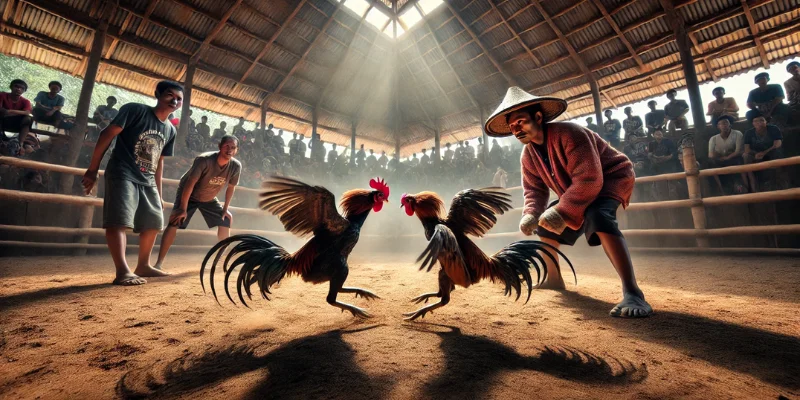 Stress Management: Keeping Your Rooster Calm and Focused
Stress Management: Keeping Your Rooster Calm and Focused
A stressed rooster is less likely to perform well in a sabong match. Daily care involves minimizing stress through proper environment and handling.
- Quiet Environment: Keep your rooster’s living area free from loud noises and sudden disturbances.
- Routine Handling: Gently handle your rooster daily to keep it accustomed to human contact. This helps reduce anxiety before a match.
- Proper Sleep: Ensure the rooster has a quiet, dark area to sleep at night. Sleep is crucial for recovery and maintaining focus.
Carlos’ Pro Insight: Roosters are sensitive to their surroundings. A calm and confident bird is more likely to perform well in intense situations.
Pre-Match Conditioning: Final Steps Before the Big Fight
In the days leading up to a fight, it’s important to fine-tune your rooster’s diet and care routine to ensure it is in peak condition.
- Reduce Training Intensity: A few days before the match, scale back on high-intensity drills to allow muscles to recover.
- Hydration Boost: Increase water intake to ensure the rooster is fully hydrated before the match.
- Special Diet: Add more protein to the diet in the final days to enhance muscle recovery and strength. Include fruits like bananas for quick energy.
Carlos’ Final Advice: Never overfeed before a match. A lighter, nutrient-dense meal ensures the rooster has energy without feeling sluggish.
Post-Fight Recovery: Ensuring Your Rooster’s Health After a Sabong Match
After a fierce sabong match, a rooster undergoes intense physical and mental stress. As a seasoned breeder and trainer, I, Carlos Mendoza, have spent years perfecting the post-fight recovery process for my roosters. Proper care after the fight not only helps your bird heal quickly but also ensures its long-term health and readiness for future matches similar to Sexy Baccarat. In this guide, I’ll walk you through effective post-fight recovery practices, from wound care to nutritional support, ensuring your rooster’s health is restored.
Immediate Post-Fight Assessment
The first step in the recovery process is an immediate evaluation of your rooster’s condition once the fight concludes.
- Visual Check: Examine your rooster’s body for visible injuries, cuts, or abrasions.
- Look for Lameness: Observe its movements. Limping or any difficulty walking may indicate deeper issues, such as sprains or fractures.
- Check for Breathing Patterns: Heavy or labored breathing could mean internal damage, while rapid breathing may suggest stress or exhaustion.
Carlos’ Tip: Always remain calm during the post-fight assessment. Your rooster picks up on your energy, and staying composed helps keep it relaxed.
Wound Care and Disinfection
In any cockfight, wounds are inevitable. Proper wound care is essential to avoid infections and speed up the healing process.
- Clean the Wounds Immediately: Use warm water or a saline solution to gently wash away dirt and blood.
- Apply Antiseptic: Disinfect the area with a mild antiseptic solution, such as iodine or hydrogen peroxide, to kill bacteria.
- Bandaging Deep Cuts: For deeper wounds, apply a sterile bandage or gauze. Secure it carefully, ensuring it stays in place but doesn’t restrict movement.
Carlos’ Pro Tip: Be cautious when handling the rooster around injuries. Keep pressure light and avoid unnecessary contact with open wounds.
Hydration: Replenishing Lost Fluids
After an intense fight, your rooster will have lost a significant amount of fluids. Dehydration can delay recovery and lead to more severe health issues.
- Offer Fresh Water: Provide clean, fresh water immediately. Your rooster should drink gradually, so don’t force it to consume large quantities at once.
- Electrolyte Solution: Add an electrolyte solution to the water to help replace lost minerals and restore balance. Electrolytes aid in preventing fatigue and boosting the recovery process.
Carlos’ Note: Always monitor the rooster’s water intake in the first few hours. Gradual hydration is more effective than rapid rehydration.
Nutritional Support for Recovery
A well-balanced post-fight diet is essential for fast recovery. A rooster’s body needs specific nutrients to heal wounds, rebuild muscle, and restore energy levels.
a. Protein for Muscle Repair
Protein plays a critical role in repairing damaged muscle tissues. Immediately after the fight, offer your rooster high-protein food sources.
- Protein-Rich Foods: Include boiled eggs, worms, and fish meal in their diet.
- Portion Size: Keep portions small but frequent to encourage consistent nutrient intake.
b. Carbohydrates for Energy Replenishment
Carbohydrates restore lost energy and help your rooster regain strength.
- Sources: Rice, corn, and sweet potatoes are ideal post-fight carbohydrate sources.
- Timing: Feed carbohydrates within 24 hours of the fight to replenish glycogen stores in the muscles.
Carlos’ Pro Insight: Avoid overfeeding in the first 12 hours after the fight. Start with light meals and gradually increase as the rooster shows signs of recovery.
Rest and Isolation for Full Recovery
A quiet and stress-free environment is critical for your rooster to heal both physically and mentally after a fight.
- Dedicated Recovery Pen: Set up a separate, clean pen away from other roosters. This pen should be spacious enough for the rooster to move comfortably, but without too much stimulation.
- Low Lighting: Keep lighting soft and dim. Bright lights can agitate the rooster, preventing it from resting.
- Limited Movement: Encourage minimal movement for the first 24 hours. This allows the rooster’s body to focus on healing without expending energy.
Carlos’ Pro Insight: Roosters need time to mentally recover from the stress of a fight. Isolation helps them calm down and prevents further injury.
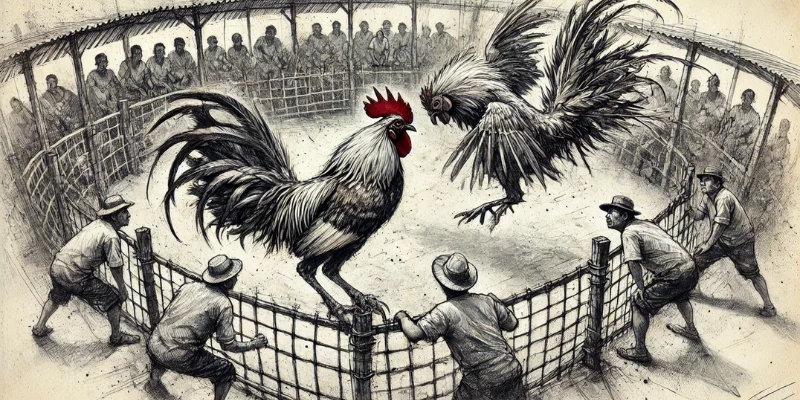 Monitoring for Infections and Complications
Monitoring for Infections and Complications
During the recovery phase, it’s important to monitor the rooster closely for any signs of infection or complications that may arise from its injuries.
- Daily Wound Checks: Inspect wounds twice daily for any signs of infection, such as redness, swelling, or discharge.
- Monitor for Fever: A rooster with a fever may exhibit lethargy, excessive sleepiness, or lack of appetite. This could indicate an infection.
- Watch for Abscesses: Sometimes, untreated wounds can develop into abscesses. If you notice any lumps or hard areas around the wound, consult a veterinarian for advice.
Carlos’ Tip: If you notice any unusual symptoms, act quickly. Early detection of complications can save your rooster from more serious health issues.
Post-Fight Massage for Muscle Relief
After a high-intensity fight, roosters may experience muscle soreness or stiffness. Massaging your rooster’s muscles can help alleviate discomfort and improve blood circulation.
- Gentle Massaging: Use soft strokes and avoid applying too much pressure, especially around sensitive areas.
- Focus on the Legs and Wings: These areas endure the most strain during a fight. A gentle massage helps release tension and improves mobility.
- Use Natural Oils: Consider using a small amount of coconut oil or olive oil to help lubricate your hands and soothe the rooster’s skin.
Carlos’ Pro Tip: Incorporating light stretching into the massage routine can further help release tension and enhance flexibility during recovery.
Reintroducing Light Exercise After Recovery
After a few days of rest, once your rooster shows signs of improvement, it’s time to gradually reintroduce light physical activity. This helps the bird regain muscle strength and restore flexibility.
- Short Walks: Start with 5-10 minutes of walking, allowing the rooster to move at its own pace.
- Controlled Wing Flapping: Encourage gentle wing flapping to stretch the muscles without overexerting the bird.
- Monitor Progress: Pay close attention to how your rooster responds to light exercises. If it shows signs of discomfort, stop immediately and extend the rest period.
Carlos’ Advice: Don’t rush the recovery process. Roosters that return to full training too soon are at risk of re-injury.
Mental Recovery: Keeping Your Rooster Calm and Focused
Mental recovery is as important as physical healing. After a fight, roosters can experience anxiety or agitation. Here’s how to help your rooster remain calm during its recovery:
- Keep Handling Minimal: While it’s important to monitor your rooster, excessive handling can cause stress. Let it rest undisturbed.
- Quiet Environment: Avoid loud noises or other roosters crowing nearby. This helps reduce anxiety and allows for full mental recuperation.
- Routine and Consistency: Stick to a regular feeding and resting schedule. Routine helps roosters feel more secure, aiding in their mental recovery.
Carlos’ Tip: A well-rested and mentally recovered rooster will perform better in its next match. Never underestimate the importance of mental health in sabong.
Final Health Check Before Returning to Training
Before you return your rooster to its regular training routine, perform a comprehensive health check to ensure it’s fully recovered.
- Full Physical Inspection: Check for any remaining cuts, bruises, or signs of infection. If all wounds are healed, proceed with the final check.
- Monitor Energy Levels: Ensure your rooster is energetic and not showing signs of fatigue or lethargy. Its movements should be agile and free from stiffness.
- Assess Weight and Muscle Tone: Roosters may lose weight during recovery. Ensure that muscle tone has been restored and weight loss hasn’t been excessive.
Carlos’ Final Advice: If your rooster passes all health checks, gradually reintroduce it to its training regimen, starting with light exercises before moving to more intense drills.
Expert Tips for Selecting the Right Rooster for Competitive Sabong
Choosing the right rooster for competitive sabong can be the difference between a quick defeat and a champion. As a breeder and trainer with decades of experience, I, Carlos Mendoza, understand that picking the right bird is both an art and a science. It involves a combination of genetics, physical traits, temperament, and preparation. This guide will provide expert tips for selecting a winning rooster that’s ready for the competitive sabong arena.
Physical Traits to Look For: Assessing a Rooster’s Build
When selecting a rooster, its physical attributes provide immediate clues about its fighting ability. Here are the key traits to evaluate:
a. Size and Weight
- Ideal Weight Range: A competitive rooster should weigh between 2-3 kg. Too light, and it may lack power. Too heavy, and it could be slow.
- Balanced Build: Look for a well-balanced body with a strong, compact frame. Avoid birds that seem too bulky or too skinny.
b. Muscle Tone and Wing Strength
- Muscle Development: Examine the chest and thigh muscles. Well-defined muscles are an indication of strength and stamina.
- Wing Span and Strength: Roosters with wide wingspans and strong wing muscles have better agility and power for delivering strikes.
c. Legs and Spurs
- Leg Strength: Strong, thick legs are essential for a rooster to hold its ground and launch powerful kicks.
- Spurs: The rooster’s spurs are its primary weapon. Check for sturdy, well-developed spurs, which will be crucial in battle.
Carlos’ Pro Tip: Spend time observing the rooster’s movement and posture. A confident stance and fluid movement indicate a well-balanced bird with potential.
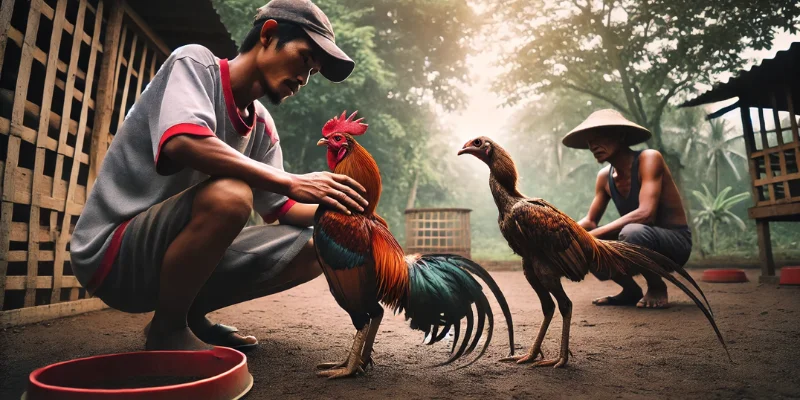 Temperament: Finding the Right Fighting Spirit
Temperament: Finding the Right Fighting Spirit
A rooster’s temperament is just as important as its physical traits. In the sabong ring, a bird must be both aggressive and intelligent to win.
- Aggression: Look for a rooster that exhibits controlled aggression. It should be willing to fight without being overly wild or unpredictable.
- Focus: A good fighter is not easily distracted. Evaluate how the rooster responds to stimuli. It should remain focused even in high-pressure situations.
- Calm Under Stress: Roosters that panic under pressure won’t fare well in the ring. Choose birds that stay composed and confident, even when challenged.
Carlos’ Insight: The best sabong roosters have a balance of aggression and focus. They should be willing to fight but smart enough to conserve their energy.
Training Potential: Willingness to Learn and Adapt
A rooster’s trainability is often an overlooked but critical factor in Online Sabong Champions success. Some birds are naturally more receptive to training than others.
- Adaptability: Choose a rooster that is quick to adapt to new training routines. Birds that pick up drills faster are often more responsive in the ring.
- Intelligence: Smart roosters learn from experience. They should be able to adjust their fighting style based on the opponent’s moves.
- Response to Conditioning: Roosters that respond well to conditioning exercises—like weight training and sparring—are more likely to excel in long-term training programs.
Carlos’ Tip: Roosters that show adaptability and willingness to learn will improve faster and become more strategic fighters in the ring.
Age and Maturity: Timing is Everything
The age of the rooster plays a crucial role in its success in Online Sabong Champions. A bird that’s too young may lack experience, while an older bird may lose its edge.
- Ideal Fighting Age: Roosters between 1.5 to 3 years are often at their peak for competitive fighting. They’ve reached physical maturity but still retain their youthful energy.
- Avoiding Overuse: A rooster that’s fought too many battles may have physical wear and tear. Look for a bird with a balance of experience and health.
- Signs of Maturity: Look for roosters that have developed strong spurs, full plumage, and a confident demeanor.
Carlos’ Tip: Timing is key. An experienced rooster with good health and mental sharpness will outperform a younger, unseasoned bird.
Choosing the Right Rooster Based on Online Sabong Champions Strategy
Your choice of rooster should align with your overall sabong strategy. Some roosters are better suited for specific types of matches, so tailor your selection to your approach.
- Offensive Strategy: If you prefer quick, aggressive fights, choose a rooster with a lean build, fast reflexes, and strong spurs.
- Defensive Strategy: For longer, endurance-based fights, look for a rooster with a broader build, thicker legs, and superior stamina.
- Hybrid Strategy: For a balance between offense and defense, select a versatile breed with good agility and stamina.
Carlos’ Pro Insight: Knowing your strategy allows you to select a rooster that complements your fighting style, maximizing your chances of success.
Why Bloodlines Matter in Online Sabong Champions
In Online Sabong Champions, the saying “breeding champions starts at birth” rings true. The bloodline of a rooster determines many of its core attributes such as strength, speed, endurance, and temperament.
- Inherited Traits: Just like humans, roosters inherit traits from their parents and ancestors. A well-bred bird is likely to display the best traits of its lineage.
- Predictability in Performance: Roosters from proven bloodlines often perform consistently. You can predict their physical and mental characteristics based on their lineage.
- Long-Term Investment: Maintaining strong bloodlines is essential for sustained success in breeding. Good genetics don’t just create one champion—they create a legacy of champions.
Carlos’ Tip: Don’t just pick a bird based on appearance. Study its bloodline for insight into its potential as a sabong champion.
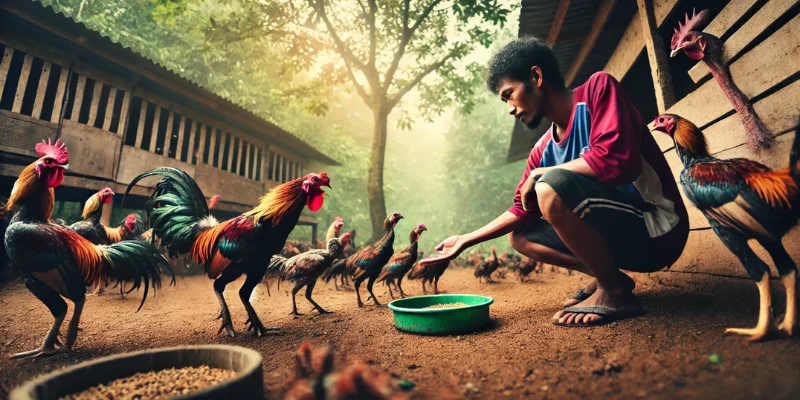 Understanding Key Rooster Bloodlines in Online Sabong Champions
Understanding Key Rooster Bloodlines in Online Sabong Champions
Online Sabong Champions bloodlines have been developed and refined over generations. Some bloodlines are more suitable for specific fighting styles, making it crucial to choose the right one for your approach.
a. Sweater Bloodline
- Traits: Known for their speed, endurance, and agility. Roosters from the Sweater line are particularly good at evading strikes while delivering powerful hits.
- Fighting Style: Sweaters excel in longer, more tactical fights. Their stamina allows them to outlast opponents.
- Temperament: They are aggressive but calculated, making them ideal for strategic fighting styles.
b. Hatch Bloodline
- Traits: Hatches are renowned for their raw power and brute strength. They often dominate in close-combat scenarios.
- Fighting Style: Known for aggressive, head-on combat, the Hatch rooster is favored by breeders looking for birds that can overpower opponents quickly.
- Temperament: Strong-willed and determined, Hatches are fighters by nature and rarely back down.
c. Roundhead Bloodline
- Traits: Roundheads are known for their agility and intelligence in the ring. They can adapt quickly to an opponent’s fighting style.
- Fighting Style: Agile and fast, Roundheads are often seen making quick, sharp strikes before dodging blows.
- Temperament: Intelligent and aggressive, these birds tend to outsmart opponents, making them excellent for strategic Online Sabong Champions.
d. Kelso Bloodline
- Traits: Kelsos are known for their endurance and versatility. These birds combine speed, strength, and the ability to adapt mid-fight.
- Fighting Style: Kelsos perform well in both offensive and defensive situations, making them a versatile choice for various match types.
- Temperament: Balanced and intelligent, they are aggressive but can also hold back when needed to conserve energy.
Carlos’ Insight: Choosing the right bloodline depends on the type of fight you anticipate. Some bloodlines excel in strength, while others prioritize speed and intelligence.
Breeding Strategy: Linebreeding vs. Crossbreeding
There are two primary breeding strategies in Online Sabong Champions: linebreeding and crossbreeding. Both approaches offer distinct advantages depending on your goals.
a. Linebreeding
- Definition: Linebreeding involves breeding birds from the same bloodline to reinforce specific traits.
- Advantages: This method helps to solidify desirable characteristics such as strength, endurance, and temperament within a single bloodline.
- Risks: Linebreeding can sometimes lead to inbreeding, resulting in weaker birds due to a limited gene pool. Monitor for signs of declining vitality or increased health problems.
b. Crossbreeding
- Definition: Crossbreeding involves mating birds from different bloodlines to combine strengths from each lineage.
- Advantages: Crossbreeding often produces stronger, more versatile roosters by blending desirable traits. This method can improve stamina, speed, and adaptability.
- Risks: There’s always a chance that negative traits from both lines can be passed on. Careful selection is crucial to avoid unwanted characteristics.
Carlos’ Pro Tip: Both methods have their place in Online Sabong Champions. For beginners, crossbreeding offers more flexibility and often results in healthier birds with a broader skill set.
Conclusion
As an experienced breeder, I, Carlos Mendoza, emphasize that the right equipment, combined with proper training techniques, can make the difference between a good rooster and a champion. From essential tools like pens and feeders to advanced equipment like leg weights and sparring spurs, each item plays a vital role in preparing your rooster for success in Online Sabong Championsmatches. Keep in mind, training isn’t just about physical conditioning—it’s also about ensuring the well-being of your rooster. With these tools and expert insights, you’ll be well on your way to raising a winning fighter.
Post-fight recovery is crucial in ensuring your rooster remains healthy and ready for future matches. From immediate wound care to gradual reintroduction into training, each step must be carefully planned and executed. As an experienced breeder and trainer, I, Carlos Mendoza, emphasize that rest, nutrition, and monitoring are the cornerstones of successful recovery. By following these post-fight recovery techniques, you can ensure your rooster stays in top condition, prepared for the next challenge in the Online Sabong Champions arena.
